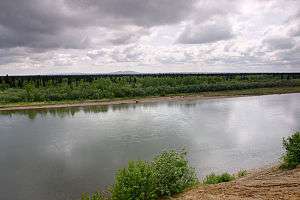Mulchatna River
The Mulchatna River is a 160-mile (260 km) tributary of the Nushagak River in the U.S. state of Alaska.[3] Beginning at Turquoise Lake, it flows generally southwest to meet the larger river 65 miles (105 km) northeast of Dillingham.[1] The Mulchatna's mouth is slightly south (downstream) of the village of Koliganek on the Nushagak, which continues southwest to Nushagak Bay, an arm of Bristol Bay.[4]
| Mulchatna River | |
|---|---|
 Mulchatna River | |
 Location of the mouth of the Mulchatna River in Alaska | |
| Location | |
| Country | United States |
| State | Alaska |
| Census Area | Dillingham |
| Physical characteristics | |
| Source | Turquoise Lake |
| • location | west of the Chigmit Mountains, Lake Clark National Park and Preserve |
| • coordinates | 60°46′56″N 154°00′30″W[1] |
| • elevation | 2,506 ft (764 m)[2] |
| Mouth | Nushagak River |
• location | 65 miles (105 km) northeast of Dillingham |
• coordinates | 59°38′40″N 157°06′55″W[1] |
• elevation | 151 ft (46 m)[1] |
| Length | 160 mi (260 km)[3] |
| Type | Wild |
| Designated | December 2, 1980 |
The upper 24 miles (39 km) of the river, which flow through Lake Clark National Park and Preserve, became part of the National Wild and Scenic River System in 1980.[5] Aside from scattered cabins, the Mulchatna River is undeveloped. However, there is a proposal to build a large copper/gold mine, the Pebble Mine, in the watershed of one of the Mulchatna tributaries, the Koktuli River.[6]
Recreation
.jpg)
The Mulchatna River and one of its tributaries, the Chilikadrotna River, are popular Southwest Alaska destinations for floatfishing. Other Mulchatna tributaries, including the Stuyahok and Koktuli rivers, are also popular fishing streams. The main game fish frequenting the Mulchatna are king salmon, silver salmon, char, Arctic grayling, and rainbow trout.[7]
Varying from Class I (easy) to III (difficult) on the International Scale of River Difficulty, the Mulchatna is floatable by many kinds of watercraft on the Class I water below Bonanza Creek. The upper 50 miles (80 km) or so of the river, however, vary between Class II (medium) and III, may require portages, and are sometimes too shallow to float. Other dangers include ledge drops and haystack waves above Bonanza Creek and possible logjams and overhanging vegetation along the rest of the river.[8]
See also
References
- "Mulchatna River". Geographic Names Information System. United States Geological Survey. March 31, 1981. Retrieved November 19, 2013.
- Derived by entering source coordinates in Google Earth.
- Orth, Donald J.; United States Geological Survey (1971) [1967]. Dictionary of Alaska Place Names: Geological Survey Professional Paper 567 (PDF). University of Alaska Fairbanks. United States Government Printing Office. p. 664. Archived from the original (PDF) on October 17, 2013. Retrieved November 19, 2013.
- Alaska Atlas & Gazetteer (7th ed.). Yarmouth, Maine: DeLorme. 2010. pp. 48–49, 57–58, 66–67, 131. ISBN 978-0-89933-289-5.
- "Mulchatna River, Alaska". National Wild and Scenic Rivers System. Retrieved November 20, 2013.
- Northern Dynasty Mines (2006). "Pebble Project: Application for Groundwater Right" (PDF). Alaska Department of Natural Resources. Retrieved November 20, 2013.
- Limeres, Rene; Pedersen, Gunnar; et al. (2005). Alaska Fishing: The Ultimate Angler's Guide (3rd ed.). Roseville, California: Publishers Design Group. pp. 235–36. ISBN 1-929170-11-4.
- Jettmar, Karen (2008) [1993]. The Alaska River Guide: Canoeing, Kayaking, and Rafting in the Last Frontier (3rd ed.). Birmingham, Alabama: Menasha Ridge Press. pp. 174–76. ISBN 978-0-89732-957-6.